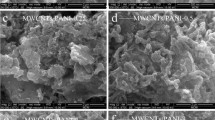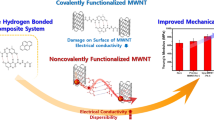Abstract
Highly conducting polyaniline (PANi)-coated multi-walled carbon nanotubes (MWCNTs) were prepared by in situ polymerization method for electromagnetic interference shielding. The thickness of the PANi coatings was controlled by the oxyfluorination treatment on the multi-walled carbon nanotubes and analyzed with both SEM and TEM. The oxyfluorination with higher oxygen content produced more hydrophilic functional groups on the surface of multi-walled carbon nanotubes. The functional groups led to the well distribution and coating of PANi on the multi-walled carbon nanotubes resulting in the higher interfacial affinity between them. The uniform coating of PANi on MWCNTs by controlling the oxyfluorination conditions also played a crucial role in increasing the electrical conductivity of nanocomposites. The improved interfacial affinity resulted in the higher electromagnetic interference (EMI) SE of 47.03 dB based on the synergistic combination of the conductive components. The EMI shielding mechanism of PANi on MWCNTs suggested that EMI was mainly shielded by adsorption to avoid secondary EMI.







Similar content being viewed by others
References
Olmedo L, Hourquebie P, Jousse F (1997) In: Nalwa HS (ed) Handbook of organic conductive molecules and polymers. Wiley, Chichester
Osawa Z, Kuwabara S (1989) Thermal stability of the shielding effectiveness of composites to electromagnetic interference. Effects of matrix polymers and surface treatment of fillers. Polym Degrad Stab 35:33–43
Huang CY, Pai JF (1997) Studies on processing parameters and thermal stabilityof ENCF/ABS composites for EMI shielding. J Appl Polym Sci 63:115–135
Chandrasekhar P (1999) Conducting polymers, fundamentals and applications: a practical approach. Kluwer, London
Baughman RH, Zakhidov AA, de Heer WA (2002) Carbon nanotubes—the route toward applications. Science 297:787–792
Fischer JE, Dai H, Thess A, Lee R, Hanjani NM, Dehaas DL, Smalley RE (1997) Metallic resistivity in crystalline ropes of single-wall carbon nanotubes. Phys Rev B 55:R4921–R4924
Huang YL, Yuen SM, Ma CCM, Chuang CY, Yu KC, Teng CC, Tien HW, Chiu YC, Wu SY, Liao SH, Weng FB (2009) Morphological, electrical, electromagnetic interference (EMI) shielding, and tribological properties of functionalized multi-walled carbon nanotubes/poly methyl methacrylate (PMMA) composites. Compos Sci Technol 69:1991–1996
Saini P, Choudhary V, Singh BP, Mathur RB, Dhawan SK (2009) Polyaniline–MWCNT nanocomposites for microwave absorption and EMI shielding. Mater Chem Phys 113:919–926
Chandrasekhar P, Naisdham K (1999) Broadband microwave absorption and shielding properties of a polyaniline. Synth Met 105:115–120
Truong VT, Riddell SZ, Muscat RF (1998) Polypyrrole based microwave absorbers. J Mater Sci 33:4971–4976
Kaynak A (1996) Electromagnetic shielding effectiveness of galvanostaticallysynthesized conducting polypyrrole films in the 300–2000 MHz frequency range. Mater Res Bull 31:845–860
Ratna D, Abraham TN, Siengchin S, Karger-Kocsis J (2009) Novel method for dispersion of multiwall carbon nanotubes in poly(ethylene oxide) matrix using dicarboxylic acid salts. J Polym Sci Pol Phys 47:1156–1165
Wu T, Chang H, Lin Y (2009) Synthesis and characterization of conductive polypyrrole/multi-walled carbon nanotubes composites with improved solubility and conductivity. Compos Sci Technol 69:639–644
Chen W, Wu J, Kuo P (2008) Poly(oxyalkylene)diamine-functionalized carbon nanotube/perfluorosulfonated polymer composites: synthesis, water state, and conductivity. Chem Mater 20:5756–5767
Zhou Y, Jeelani MI, Jeelani S (2009) Development of photo micro-graph method to characterize dispersion of CNT in epoxy. Mater Sci Eng A 506:39–44
Yun J, Im JS, Lee YS, Bae TS, Lim YM, Kim HI (2010) pH and electro-responsive release behavior of MWCNT/PVA/PAAc composite microcapsules. Colloids Surf A Physicochem Eng Asp 368:23–30
Yun J, Im JS, Lee YS, Kim HI (2010) Effect of oxyfluorination on electromagnetic interference shielding behavior of MWCNT/PVA/PAAc composite microcapsules. Eur Polym J 46:900–909
Im JS, Park SJ, Lee YS (2009) The metal–carbon–fluorine system for improving hydrogen storage by using metal and fluorine with different levels of electronegativity. Int J Hydrog Energy 34:1423–1428
Park OK, Jeevananda T, Kim NH, Kim SI, Lee JH (2009) Effects of surface modification on the dispersion and electrical conductivity of carbon nanotube/polyaniline composites. Scripta Mater 60:551–554
Arepalli S, Nikolaev P, Gorelik O, Hadjiev VG, Holmes W, Files B, Yowell L (2004) Protocol for the characterization of single-wall carbon nanotube material quality. Carbon 42:1783–1791
Wu Z, Li J, Timmer D, Lozano K, Bose S (2009) Study of processing variables on the electrical resistivity of conductive adhesives. Int J Adhes Adhes 29:488–494
Im JS, Kim JG, Lee YS (2009) Fluorination effects of carbon black additives for electrical properties and EMI shielding efficiency by improved dispersion and adhesion. Carbon 47:2640–2647
Park SJ, Song SY, Shin JS, Rhee JM (2005) Effect of surface oxyfluorination on the dyeability of polyethylene film. J Colloid Interface Sci 283:190–195
Chamssedine F, Claves D (2008) Selective substitution of fluorine atoms grafted to the surface of carbon nanotubes and application to an oxyfluorination strategy. Carbon 46:957–962
Kodjie SL, Li L, Li B, Cai W, Li CY, Keating M (2006) Morphology and crystallization behavior of HDPE/CNT nanocomposite. J Macromol Sci Part B-Phys 45:231–245
Konyushenko EN, Stejskal J, Trchová M, Hradil J, Kovářová J, Prokeš J, Cieslar M, Hwang JY, Chen KH, Sapurina I (2006) Multi-wall carbon nanotubes coated with polyaniline. Polymer 47:5715–5723
Makeiff DA, Huber T (2006) Microwave absorption by polyaniline–carbon nanotube composites. Synth Met 156:497–505
Dhawan SK, Singh K, Bakhshi AK, Ohlan A (2009) Conducting polymer embedded with nanoferrite and titanium dioxide nanoparticles for microwave absorption. Synthetic Met 159:2259–2262
Al-Saleh MH, Sundararaj U (2009) Electromagnetic interference shielding mechanisms of CNT/polymer composites. Carbon 47:1738–1746
Acknowledgement
This study was financially supported by a research fund of Chungnam National University in 2010.
Author information
Authors and Affiliations
Corresponding author
Rights and permissions
About this article
Cite this article
Yun, J., Im, J.S., Kim, HI. et al. Effect of oxyfluorination on electromagnetic interference shielding of polyaniline-coated multi-walled carbon nanotubes. Colloid Polym Sci 289, 1749–1755 (2011). https://doi.org/10.1007/s00396-011-2496-7
Received:
Accepted:
Published:
Issue Date:
DOI: https://doi.org/10.1007/s00396-011-2496-7




